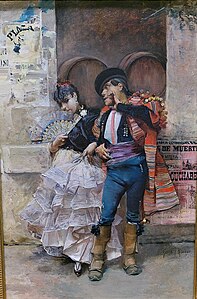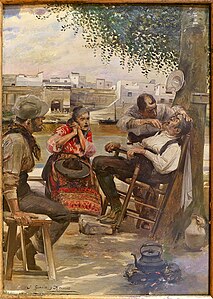José García Ramos
This article needs additional citations for verification. (May 2020) |

José García Ramos (1852,
Biography
He attended the "Escuela Provincial de Bellas Artes de Sevilla" at the age of nine, where he studied with
In 1877, he visited Naples and Venice and, in 1882, returned to Spain with a brief side trip to Paris. Later, he was named a Professor at the "Escuela de Artes Industriales" and an Academician at the Real Academia de Bellas Artes de Santa Isabel de Hungría. He also worked as an illustrator for several publications; notably La Ilustración Artística, La Ilustración Española y Americana and Blanco y Negro. He won third prize at the Exposition Universelle (1900).
His favorite themes were traditional in nature and he is considered a major exponent of Andalusian regional painting. In 1917, a group of artists proposed erecting a memorial gazebo in the Jardines de Murillo. The government accepted the proposal, it was paid for with funds collected by the artists, and was opened to the public in 1923.
Many of his best known works may be seen at the Carmen Thyssen Museum in Málaga[1] and at the Museo del Prado.
Selected paintings
-
A Pair of Sevillian Dancers
-
Checkmate
-
Leaving a Masked Ball
-
Barber Pulling a Tooth
References
- ^ Works and commentary by José Luis Díez @ the Museo Carmen Thyssen
Further reading
- Enrique Valdivieso: Historia de la pintura sevillana, 1992. Guadalquivir S.L.. Ediciones. ISBN 84-8608-076-2.
External links
- More works by García @ ArtNet
- Biography and works @ the Museo del Prado
- Biography @ MCN Biografías




